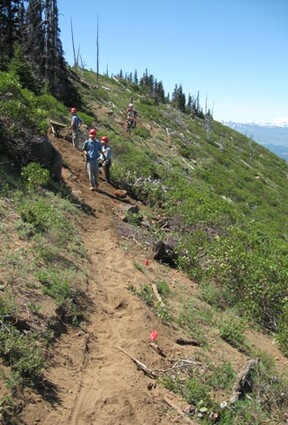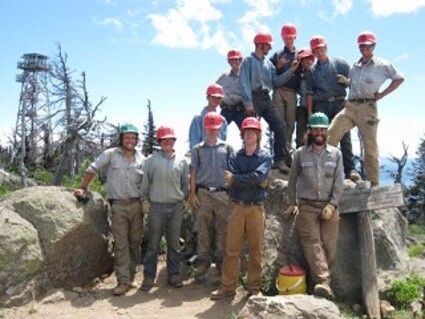Youth crew restores Black Butte summit
Last updated 7/12/2011 at Noon

The Red Crew had a once-in-a-lifetime experience restoring Black Butte’s summit trail.photo provided
Their faces were streaked with dirt, but they had a certain glow about them that wasn't just sunburn. The 12-person "Red" Crew of the Northwest Youth Corps, a youth development and outdoor education organization, spent last week undertaking the largest restoration project ever performed on the summit of Black Butte. They improved one of Central Oregon's favorite hiking trails, restored habitat - and rescued a baby golden eagle to boot.
The mountaintop has been the most important fire lookout in the Sisters area since about 1910. At least six fire detection structures have been constructed on the 6,400-foot-high summit in the past 100 years with the help of everything from mules to helicopters.
People have been visiting the summit for much longer. Native Americans once foraged for important plant foods on the butte or went there on spirit quests. Civilian Conservation Corp crews building the Metolius River Campgrounds wrote their names in the outhouse in the '40s. Today thousands of hikers brave the 1,400-foot elevation gain on the two-mile-long trail to reach 360-degree views of Central Oregon and see the lookout tower and other rustic buildings.
The shifting footprints of fire detection structures, living quarters, outhouses, and hikers have left a mark on the subalpine vegetation and that is what the Red Crew was hired to fix. Directed by Deschutes National Forest Recreation Specialists Chris Sabo and Steve Hayden, the crew relocated the top quarter mile of the summit trail and restored a network of user trails created by people wandering around the summit.
Damage was particularly evident around the base of the 1995 lookout, where many people gathered hoping to climb the tower, which is not open to the public. Many hikers never realized that better views and historic buildings were just around the corner.
Chris Sabo explained, "With the high use of 200-300 people on busy days, the protection of the natural resources had become quite critical to us. This trail relocation was a great solution by providing an attractive and less confusing route to the views."
The trail move also facilitates the upcoming construction of a seventh building on Black Butte, the new lookout ground house which replaces the ant-infested cabin built in 1979 and shrinks the footprint of the fire detection operation for both sustainability and efficiency.
The lookout tower and the new living quarters will be able to share batteries powered by solar arrays and propane tanks. When Forest Service planners realized the summit trail would be passing near the bedroom window of the new cabin, privacy was also an issue to solve.
Fire lookouts live on the summit from May through October, and the hundreds of visitors on a busy day can be distracting to their work and evening hours. A trail relocation was in order, a move that would better separate the recreation use and fire detection, allow restoration work to be done, and provide better experiences for everyone.
As the Red Crew took a break last Thursday in the shade of a subalpine fir, they talked about their week of living on a mountaintop.
Crew member Anthony Molinari said, "This is the coolest job I've ever had. When you wake up in the morning it never fails to amaze... the sunrise, the mountain shadow, the views." His crewmate Peter Kline agreed: "This is a once-in-a-lifetime experience."
But it wasn't all awe-inspiring. Getting tools, supplies, and camping equipment to the summit required the crew to do two back-to-back hikes up the butte, with 30-to-70-pound packs, one hike at 5 a.m. and the next at 9 a.m. The heat, blowing dust, and rations of freeze-dried food, gorp, rice and noodles also got old, fast.
Asked what they were thinking about when they finished the job and rejoined civilization, the list was short: "A shower, a burger, and some ice cream!"
Hot days of moving rock, wood, and soil at high elevation also require close attention to drinking enough water. The crew typically goes through 30 gallons of water a day, and getting it to the top of Black Butte was a logistical problem.
A Forest Service Sherpa Plane, especially equipped to drop supplies to firefighters in remote locations, was called in to help. The free air show delighted hikers as 12 packages of water containers were dropped from about 500 feet, attached to colorful parachutes. The Red crew reported the pilot's aim was "pretty good," but five drops flew past the top of the mountain with the wind and had to be retrieved.

Young trail workers celebrated at the Black Butte summit. Time for a shower, a burger and some ice cream. photo provided
The crew made the news across Central Oregon when they discovered a dehydrated young golden eagle in the Black Butte parking lot on their first day on the job. One crew member stayed with the eaglet to guard it from dogs and cars until help arrived to take the bird to a wildlife rehab facility.
All in a day's work for the Red Crew.
Black Butte Lookout Scott Brownwood appreciated the crew's help moving his own water drop of 250 gallons, which came by helicopter later in the day.
"These guys saved my life by moving that water," he said. "The heli-tack crew got called off on a fire and it would have taken me forever."
He reported he had already seen a great difference in the first two days of the trail relocation. People seem less confused and the lookout is less distracted.
"I think it will be better for everyone and more enjoyable for the hikers, the lookout, and the mountain."
















Reader Comments(0)